- Home
- Larry McMurtry
The Colonel and Little Missie
The Colonel and Little Missie Read online
Praise for The Colonel and Little Missie
“Western stalwart McMurtry is still in the myth-busting biz. He digs deep into the tropes and legends of Buffalo Bill Cody and Annie Oakley.”
—Gilbert Cruz, Entertainment Weekly
“What makes this volume a delight is McMurtry’s singular prose style. . . . One thinks of the belles lettres tradition of Hazlett and DeQuincy, Edmund Wilson and H. L. Mencken, T. S. Eliot, Gertrude Stein and Joseph W. Krutch, writers whose wit and wisdom complemented their mental elasticity.
—Clay Reynolds, Houston Chronicle
“In this informal, extremely entertaining tour of his own, McMurtry covers a lot of old ground and reverses the usual biographic track that starts with the historical record and ends in folklore. It is a pleasure to ride along.”
—Bill Bell, Daily News (New York)
“A compelling look at two phenoms of the late 19th century, by Mr. Wild West himself. McMurtry knows his territory. . . . The author of the Pulitzer-winning Lonesome Dove is ever fascinating and knowledgeable. . . . All in all, earnestly winning, old-fashioned storytelling.”
—Kirkus Reviews
“The Colonel [and Little Missie] is charming, entertaining and instructive.”
—Harry Levins, St. Louis Post-Dispatch (Missouri)
“McMurtry’s affectionate and thoughtful meditation on Buffalo Bill and Annie Oakley, and the beginnings of superstardom, is a pleasure to read.”
—Christopher Corbett, Baltimore Sun (also appeared in Newsday [New York] and The Wichita Eagle)
“McMurtry has an eye for vivid detail, and . . . prods a reader’s imagination to bring a distant age alive.”
—Michael Joseph Gross, The Boston Globe
“McMurtry’s narrative is well researched and made all the more interesting by the informal, almost conversation[al] style that has served him so well in his great body of work.”
—Cliff Ballamy The Herald-Sun (Durham, NC)
“A comforting, readable and human account.”
—Philip A. Stephenson, Pittsburgh Post-Gazette (Pennsylvania)
“Perhaps better and more thoroughly than any 20th- and 21st-century writer, McMurtry brings the personalities of the West intimately to readers—and he has done so in his latest work, The Colonel and Little Missie. . . . The delicious part of this book, superstars aside, is McMurtry. His writing is engaging, personable, credible and fun. . . . Readers will . . . enjoy the book because of McMurtry’s seasoned and intimate way of telling a story.”
—Cathie Beck, Rocky Mountain News (Denver, CO)
“Fast-paced and colorful meditation on a Western theme. . . . As long as Larry McMurtry cares to amble through the West, many of us will gladly follow.”
—Copley News Service
“The book’s aim, to separate fact from folklore, is beautifully accomplished. . . . This book’s a delight.”
—Publishers Weekly
BY LARRY MCMURTRY
Telegraph Days
Oh What a Slaughter
The Colonel and Little Missie
Loop Group
Folly and Glory
By Sorrow’s River
The Wandering Hill
Sin Killer
Sacajawea’s Nickname: Essays on the American West
Paradise
Boone’s Lick
Roads
Still Wild: A Collection of Western Stories
Walter Benjamin at the Dairy Queen
Duane’s Depressed
Crazy Horse
Comanche Moon
Dead Man’s Walk
The Late Child
Streets of Laredo
The Evening Star
Buffalo Girls
Some Can Whistle
Anything for Billy
Film Flam: Essays on Hollywood
Texasville
Lonesome Dove
The Desert Rose
Cadillac Jack
Somebody’s Darling
Terms of Endearment
All My Friends Are Going to Be Strangers
Moving On
The Last Picture Show
In a Narrow Grave: Essays on Texas
Leaving Cheyenne
Horseman, Pass By
BY LARRY MCMURTRY AND DIANA OSSANA
Pretty Boy Floyd
Zeke and Ned
Larry McMurtry
The Colonel and Little Missie
Buffalo Bill, Annie Oakley, and the Beginnings of Superstardom in America
SIMON & SCHUSTER PAPERBACKS
Rockefeller Center
1230 Avenue of the Americas
New York, NY 10020
www.SimonandSchuster.com
Copyright © 2005 by Larry McMurtry
All rights reserved, including the right of reproduction in whole or in part in any form.
First Simon & Schuster paperback edition 2006
SIMON & SCHUSTER PAPERBACKS and colophon are registered trademarks of Simon & Schuster, Inc.
For information about special discounts for bulk purchases, please contact Simon & Schuster Special Sales at 1-800-456-6798 or [email protected].
Designed by Karolina Harris
Photography consultant: Kevin Kwan
Manufactured in the United States of America
10 9 8 7 6 5 4 3 2 1
The Library of Congress has cataloged the hardcover edition as follows:
McMurtry, Larry.
The colonel and Little Missie: Buffalo Bill, Annie Oakley, and the beginnings of superstardom in America / Larry McMurtry.
p. cm.
Includes bibliographical references and index.
1. Buffalo Bill, 1846–1917. 2. Oakley, Annie, 1860–1926. 3. Entertainers—United States—Biography. 4. Shooters of firearms—United States—Biography. 5. Scouts and scouting—West (U.S.)—Biography. 6. Buffalo Bill’s Wild West Company. 7. Wild West shows. I. Title.
GV1821.B8M38 2005
978.02'092'2—dc22
[B] 2005042515
ISBN-13: 978-0-7432-7171-4
ISBN-10: 0-7432-7171-8
ISBN-13: 978-0-7432-7172-1 (Pbk)
ISBN-10: 0-7432-7172-6 (Pbk)
eISBN-: 978-1-4391-2818-3
“Buffalo Bill’s,” Copyright 1923, 1951, © 1991 by the Trustees for the E. E. Cummings Trust. Copyright © 1976 by George James Firmage, from COMPLETE POEMS: 1904–1962 by E. E. Cummings, edited by George J. Firmage. Used by permission of Liveright Publishing Corporation.
Photo credits will be found on page 245.
Contents
Superstardom
BOOK ONE
The Tropes
BOOK TWO
The Troupes
Annie
Grandmother England
Western Heroes, Heroines, and Villains
Bibliography
Index
The Colonel and Little Missie
Superstardom
1
KINGS and potentates, and their queens and lovers, someday die and have to be entombed, interred, or consumed on splendid pyres.
So too with performers—even the greatest among them, the true superstars. Elvis died, and Garbo, and Marilyn Monroe, and Frank Sinatra. Elvis at least left us Graceland, his Taj on Old Man River; of the others we have merely records and movies, recorded performances that allow us at least distant glimpses of their gaiety, their beauty, their gifts. Show business imposes its own strict temporality: no matter how many CDs or DVDs we own, it would still have been better to have been there, to have seen the living performers in the richness of their being and to have participated, however briefly, in the glory of their performance.
When I was eight yea
rs old, I was sitting in a hot pickup near Silverton, Texas, bored stiff, waiting for my father and two of my uncles, Charlie and Roy McMurtry, to conclude a cattle deal. I was reading a book called Last of the Great Scouts, by Helen Cody Wetmore, Buffalo Bill Cody’s sister. At the time I was more interested in the Lone Ranger than in Buffalo Bill Cody, but when my father and my uncles finally returned to the pickup, my Uncle Roy noticed the book and reminded Uncle Charlie that they had once seen Cody. This had occurred in Oklahoma, near the end of Cody’s life, when he had briefly merged his Wild West with the Miller Brothers’ 101 Ranch show. Both agreed that Cody, an old man at this time, hadn’t actually done much; mainly he just rode around the arena on his white horse, Isham, waving to the crowd.
Still, there was Buffalo Bill Cody, one of the most famous men in the world, and they had seen him with their own eyes.
Sixty years have passed since that hot afternoon in Silverton. I mainly remember the heat in the pickup—but it was true that two of my uncles, not men to veer much from the strict path of commerce, did perk up a bit when they remembered that they had actually seen Buffalo Bill Cody ride his white horse around an arena in Oklahoma. And like millions of others, they had made a trip precisely for that purpose, such was Cody’s fame.
2
BUFFALO BILL and Annie Oakley were, in my opinion, the first American superstars—in the 1880s and 1890s, at the height of their fame, their images were recognized the world over. Buffalo Bill was probably the most famous American of his day; he was easily more famous than any president, more famous even than Theodore Roosevelt.
Annie Oakley, in the days just before the movies took off, was as popular as any actress. One thing she and Cody had in common was that they had both killed game and sold the meat in order to support their families. Little Phoebe Ann Moses—Annie’s real name—used a heavy, muzzle-loading gun to shoot rabbits and quail, which found their way through a middleman to restaurants in Cincinnati. She became Annie Oakley, Oakley being a district of Cincinnati.
For most of her sixteen seasons with Buffalo Bill’s Wild West, she was probably the most celebrated female performer in the world. The short, slight, young-and-then-not-so-young country girl from Darke County, Ohio, equably took the measure of such folks as Queen Victoria; her son Edward, Prince of Wales; his wife, Princess Alexandra; the Austrian emperor Franz Josef; Bismarck; Kaiser Wilhelm II; and of course, the difficult Hunkpapa leader Sitting Bull, who adored her and even adopted her, sort of.
William Frederick Cody’s first fame came as a hunter, of course; the slightest of his kills probably outweighed all Annie’s rabbits and quail. In his season as a hunter for the Union (later Kansas) Pacific Railroad, Cody probably killed around three thousand buffalo. His wife, Louisa (usually shortened to Lulu), estimated that her husband, who with his crews of butchers usually took only the choice parts of the buffalo, may have left as much as 3 million pounds of buffalo meat to go to waste. He was not—as we shall see—either the first or the last hunter to be called Buffalo Bill, but he was easily the most famous.
From the early 1880s to the end of his life, in 1917, Buffalo Bill Cody was about as famous as anyone could be. He was the hero of no less than seventeen hundred dime novels, many of them written by the wildly prolific pulper Colonel Prentiss Ingraham.
And in Cody’s case, the fame didn’t exactly die with the man—at the end of the twentieth century, Buffalo Bill’s Wild West was still pulling in crowds at Euro Disney, in France, a country where Americans are not thought to be popular. Few showmen have managed to project their acts over more than a century.
3
IN show business, superstardom of the sort achieved by Buffalo Bill and Annie Oakley needs certain preconditions to be met; in America those conditions didn’t coalesce until the fourth quarter of the nineteenth century. Rapid and reliable rail transport was one such precondition. At the height of its popularity Buffalo Bill’s Wild West employed more than five hundred people, and transported hundreds of animals as well. The 1885 tour, the first to be really profitable, played in more than forty cities—later the show made as many as 130 stops in a year. Without good railroads the troupers could not have made these dates; similarly, without ocean liners, they could not have become such a great international success.
But the making of superstars requires more than trains that run on time to lots of cities. Management and publicity are necessary elements too, as the career in our own day of Madonna illustrates. It was always obvious that Madonna was going to go to the top, and then over the top, but she could not have got there so quickly and lucratively but for the efforts of Freddie DeMann, her manager, and Liz Rosenberg, her publicist.
Fortunately, from the early 1880s on, Buffalo Bill’s Wild West profited from the services of an extraordinary manager, Nate Salsbury, and a gifted press agent, Major John M. Burke, both of whom the Colonel and Little Missie often frustrated.
Nate Salsbury, a stage star himself, was an unimposing-looking man who did not particularly like performers and resented having to give them individual billing. Nonetheless, he happened to be sitting around the big arena in Louisville, Kentucky, one day in 1885 when a young female sharpshooter (Annie Oakley) and her husband-manager, Frank Butler, happened to be rehearsing their act. At this time shooting acts abounded—Cody had already turned the Butlers down once; sixteen female sharpshooters were even then blasting their way around America. Annie Oakley and Frank Butler had been performing with vaudeville, and with the Sells Circus, and generally wherever they could get a booking. It was with some reluctance that they had even been offered an audition, but before the rehearsal was even well begun, the hard-to-impress Nate Salsbury suddenly came alive. He rushed over to the young couple and urged them to let him send them downtown to have some up-to-date tintypes made. He also immediately ordered $7,000 worth of posters featuring the young sharpshooter, Annie Oakley. Later, Salsbury told Cody that Annie was a “daisy” who could easily put their retiring sharpshooter, Captain Adam H. Bogardus, in the shade.
When the critical moment came, Annie Oakley walked out in Louisville before seventeen thousand people and began the brilliant career that would more than justify Nate Salsbury’s surprising expenditure.
For the next fifteen years, with both Buffalo Bill and Annie Oakley huge superstars, Cody and Salsbury’s Wild West had many glorious runs, both in America and in Europe.
The show’s success was not accidental, however. Both Cody and Annie understood costume and appearance; both were consummate performers, though Cody’s performances consisted mostly of showing off his own good looks and excellent horsemanship. Nate Salsbury organized the tours and hired the performers, while John M. Burke, usually known as Major Burke, hustled the press and got out the crowds. But the show had a big payroll—some runs were profitable and some weren’t. As the nineteenth century gave way to the twentieth, competition was rampant, and things began to slow down. Nate Salsbury, who had been in increasingly poor health for some years, died in 1902; he was deeply mourned by Annie Oakley, Buffalo Bill, and many of the performers. Salsbury had been the Great Organizer; Cody had seldom organized anything more complicated than a buffalo hunt. As a businessman he had been almost as bad as his fiscally suicidal contemporaries Mark Twain and Ulysses S. Grant. Like them he invested wildly in mines, irrigation schemes, hotels (usually in places tourists had no interest in going), and even products such as White Beaver’s Laugh Cream, the Great Lung Healer, an herbal remedy that reached drugstores roughly a century too soon.
With Salsbury dead, everyone expected Buffalo Bill’s Wild West to quickly collapse, but it didn’t. Cody never liked working at a desk or dealing with day-to-day business details, but he could do it when he had to, and he did do it until he was able to hire another highly competent manager, James Bailey, the less-well-known half of Barnum and Bailey, who, if anything, was more competent than Salsbury. Under his management the troupe had several good runs, but times were changing—there were as many as two doz
en troupes wandering around America, flooding the market to such an extent that the public grew weary of so much Wild West. Some companies failed outright, while others merged, but Wild West shows seemed, for a time, to be everywhere.
Young Will Rogers, who would become a superstar himself, was mightily impressed by the rope tricks of Vincente Orapeza while visiting the big Chicago Exposition in 1893. Will went home to Oklahoma and began to practice rope tricks himself. Not long afterward he went to South Africa on a cattle boat and was soon doing rope tricks for audiences that included Mohandas Gandhi himself, then a young lawyer in Johannesburg. The Wild West, in its theatrical form, seemed to be everywhere. When Henry Adams and his friend the artist John LaFarge made their somewhat libidinous trip to Polynesia, they traveled with a Wild West troupe bound for Australia.
Buffalo Bill Cody continued to be much the biggest name in the business—by this time Annie Oakley had retired, though she reemerged from time to time to compete in shooting contests, nearly all of which she won.
Cody liked Indians, and from the beginning hired far more of them than any other impresario, though this involved frequent difficulties with the Department of the Interior and the commissioner of Indian Affairs, whose wards the Indians were. Eventually Cody supplemented his Indian performers with horsemen of many types—Cossacks, Arabs, and so on—whom he called his Congress of Rough Riders of the World, a nomenclature Theodore Roosevelt would eventually appropriate.
Cody and Annie Oakley traveled together for sixteen seasons, and were always respectful of one another, if not exactly close. She always addressed him as Colonel, the rank he had more or less adopted for himself, and he always called her Missie, though she was a married woman for more than forty years. Annie Oakley liked her privacy, and Cody, as we’ll see, never knew quite what to make of any woman, Annie Oakley included. It may be that these courtesy titles helped the two performers get along.

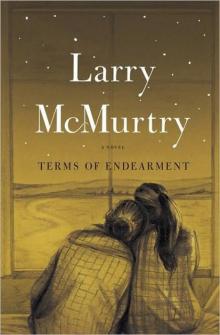 Terms of Endearment
Terms of Endearment Some Can Whistle
Some Can Whistle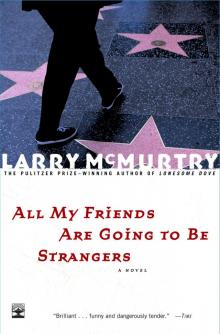 All My Friends Are Going to Be Strangers
All My Friends Are Going to Be Strangers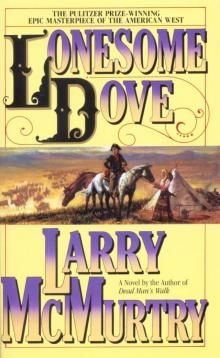 Lonesome Dove
Lonesome Dove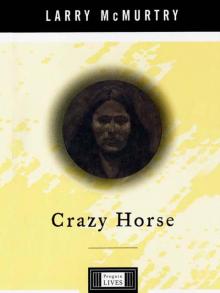 Crazy Horse: A Life
Crazy Horse: A Life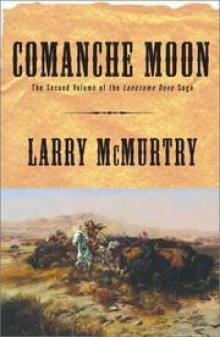 Comanche Moon
Comanche Moon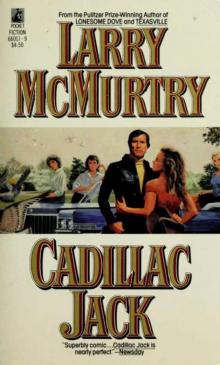 Cadillac Jack
Cadillac Jack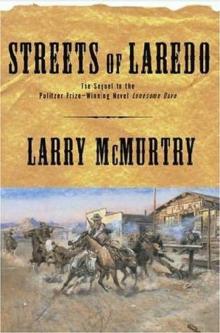 Streets of Laredo
Streets of Laredo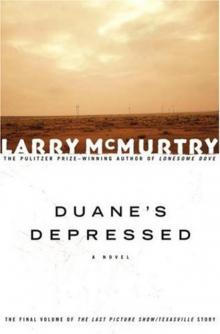 Duane's Depressed
Duane's Depressed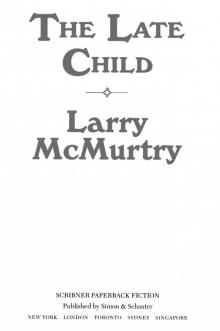 The Late Child
The Late Child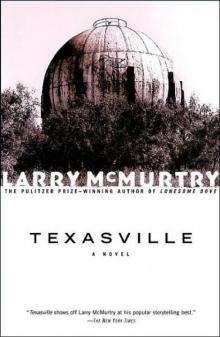 Texasville
Texasville Rhino Ranch
Rhino Ranch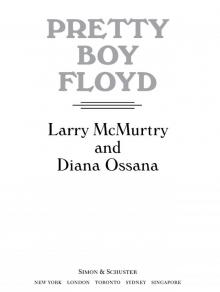 Pretty Boy Floyd
Pretty Boy Floyd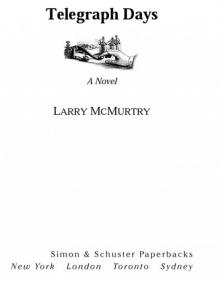 Telegraph Days
Telegraph Days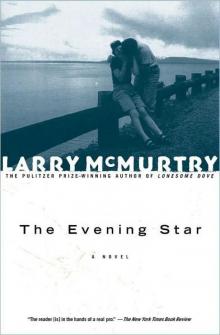 The Evening Star
The Evening Star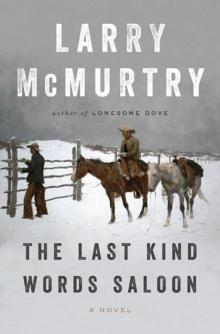 The Last Kind Words Saloon
The Last Kind Words Saloon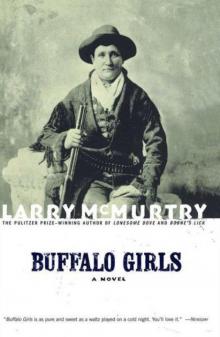 Buffalo Girls
Buffalo Girls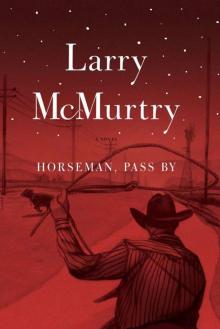 Horseman, Pass By
Horseman, Pass By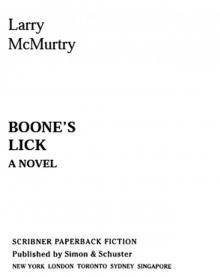 Boone's Lick
Boone's Lick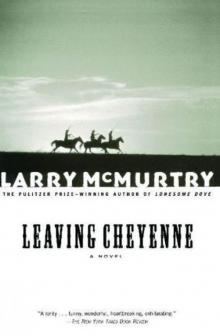 Leaving Cheyenne
Leaving Cheyenne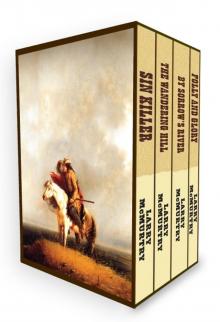 Sin Killer
Sin Killer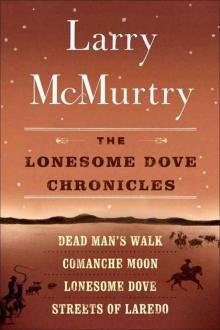 The Lonesome Dove Chronicles (1-4)
The Lonesome Dove Chronicles (1-4)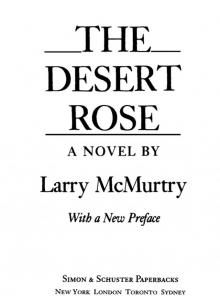 The Desert Rose
The Desert Rose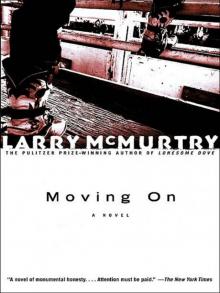 Moving On
Moving On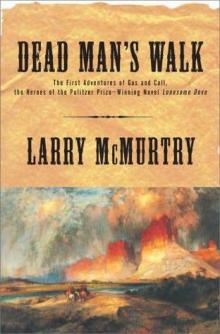 Dead Man's Walk
Dead Man's Walk The Last Picture Show
The Last Picture Show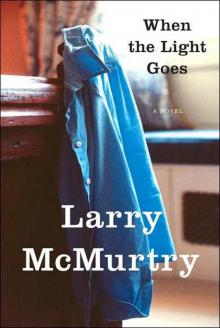 When the Light Goes
When the Light Goes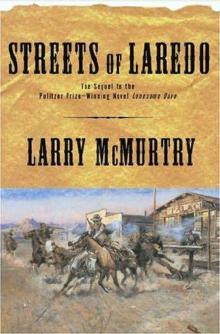 Streets Of Laredo ld-2
Streets Of Laredo ld-2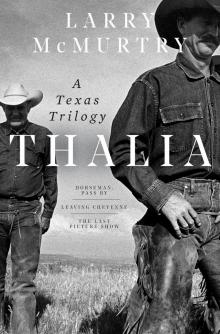 Thalia
Thalia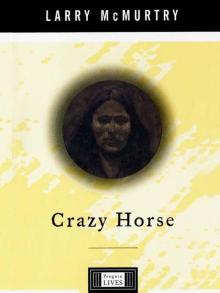 Crazy Horse
Crazy Horse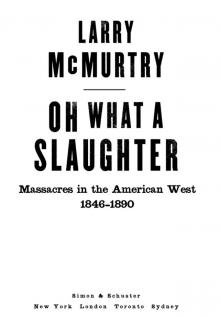 Oh What a Slaughter
Oh What a Slaughter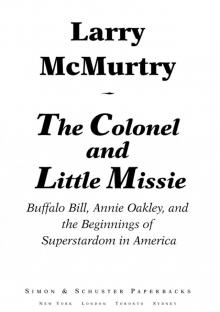 The Colonel and Little Missie
The Colonel and Little Missie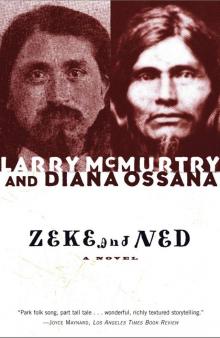 Zeke and Ned
Zeke and Ned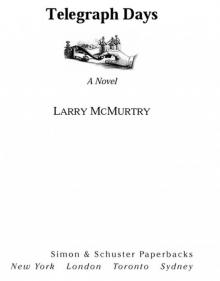 Telegraph Days: A Novel
Telegraph Days: A Novel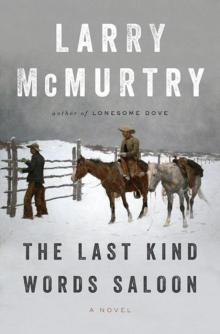 The Last Kind Words Saloon: A Novel
The Last Kind Words Saloon: A Novel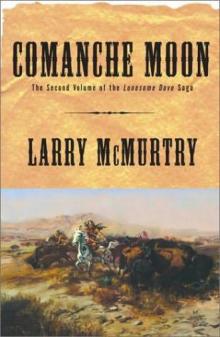 Comanche Moon ld-4
Comanche Moon ld-4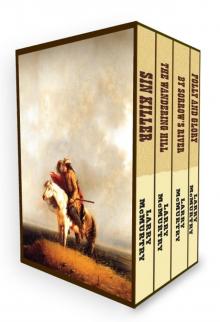 The Berrybender Narratives
The Berrybender Narratives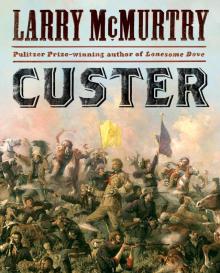 Custer
Custer